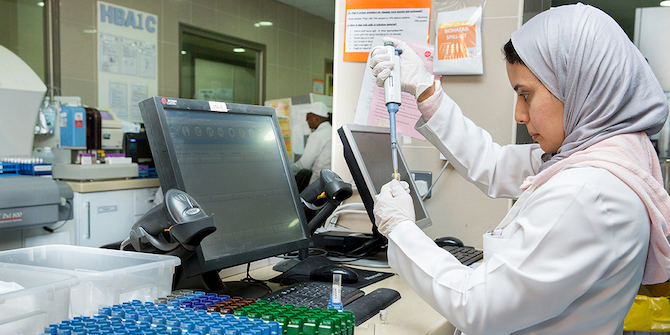By Athanasia S. Kalaitzi and Trevor W. Chamberlain

Shuwaikh Port, Kuwait. Source: Kuwait Ports Authority
The positive effect of exports on economic growth is widely documented in the growth and development literature. Exports lead to increased investment, technological advance and import expansion, all of which contribute to economic growth. In turn, economic growth can lead to further export expansion by fostering the adoption of technology and increasing the level of imports used as inputs for export-oriented production. However, the degree to which exports positively affect economic growth and, in turn, further expansion of exports, depends on the categories of exports and imports in which the expansion occurs.
For many countries, extant evidence suggests that the expansion of primary exports can impede economic growth, while manufactures offer positive externalities and knowledge spillovers to non-export sectors. In contrast, primary imports can accelerate economic growth, as they can be used as inputs in domestic production. In addition, imports of manufactured goods can contribute to economic growth through technology transfer and know-how. But are the above relationships valid in the case of Kuwait?
Over the last five decades, Kuwait has experienced significant trade growth. Real (inflation-adjusted value) manufactured exports increased at an average annual growth rate of 8.9 percent, while primary and manufactured imports increased at average annual growth rates of 5.2 and 6.0 percent respectively. Although trade has increased significantly, the real gross domestic product (GDP) of Kuwait has increased at an average rate of 2.3 percent, while the world average and that of high income countries has been estimated to be 3.1 and 2.6 percent respectively for the same period. Have manufactured exports been responsible for economic growth in Kuwait? In addition, which categories of imports have contributed most to export diversification and to economic growth?
Previous research for Kuwait has shown that aggregate exports and imports have caused economic growth in the short run but in the long run the causality has run from growth and imports to exports. However, the effect of manufactured exports and disaggregated imports has not been examined at all. In our LSE Kuwait Programme project, we investigate whether an increase in the degree of trade diversification (change in the country’s trade basket) will foster further economic growth in Kuwait in an effort to inform the process of designing future policies for sustaining and accelerating economic growth.
Our results to date show that manufactured exports and disaggregated imports, together with domestic investment and human capital, have contributed to Kuwait’s economic growth in the short run. In turn, economic growth has created new needs that could not be covered by domestic production, leading to the expansion of both primary and manufactured imports.
However, this pattern does not hold in the long run. In the long run, the causality runs from primary and manufactured imports to manufactured exports, indicating that import expansion due to further economic growth in the short run drives long run export diversification. At the same time, there is no evidence that manufactured exports contribute to long run economic growth.
Is it possible that an aggregate measure of manufactured exports masks the effects of its sub-categories on economic growth? If so, which categories of manufactured goods will foster sustained economic growth as the export demand for oil peaks and begins to decline? These questions will be examined in the next stage of our research.
In particular, manufactured exports will be disaggregated with a view to identifying the categories of manufactured exports into which Kuwait should diversify, as the world moves away from its dependence on fossil fuels.







1 Comments